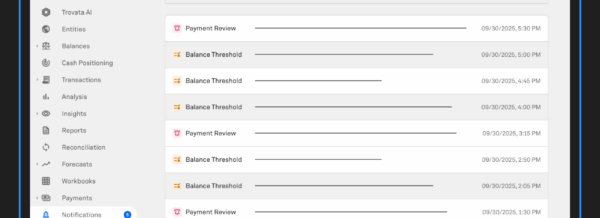In today’s fast-paced business environment, technology is the backbone of operations. However, the relentless pursuit of innovation often leaves behind a trail of outdated systems and processes, collectively known as tech debt. This invisible burden can silently erode efficiency, stifle growth, and drain financial resources. In fact, one McKinsey study even showed that tech debt accounts for around 40% of IT balance sheets across different sectors. Treasury departments, the financial nerve centers of organizations, are particularly susceptible to the crippling effects of treasury tech debt.
Outdated systems, manual processes, and inefficient workflows can hinder treasury teams from achieving their strategic goals. This blog post will delve into the nature of tech debt, its specific impact on treasury functions, and practical strategies to overcome its challenges. By understanding the costs associated with tech debt and the benefits of modernization, treasurers can make informed decisions to transform their departments into strategic business partners.
Let’s explore how treasurers can break free from the shackles of tech debt and unlock the full potential of their organizations.
What is Tech Debt?
Tech debt is the long-term cost incurred by a company due to choosing a faster, easier, or cheaper solution now, rather than using a better approach that would take longer. It’s essentially the technical equivalent of financial debt, where interest is paid in the form of reduced productivity, increased risk, and higher maintenance costs.
The Weight of Inherited Systems
Many companies grapple with the burden of inherited systems. These legacy platforms, while once fit for purpose, often become bottlenecks as business evolves. They are like old cars; they still run, but with diminishing reliability and increasing maintenance costs.
The Impact of Tech Debt
The repercussions of tech debt are far-reaching, affecting both the bottom line and operational efficiency.
- Hard Costs: These are the tangible financial burdens. They include system maintenance, upgrades, and the cost of workarounds. Over time, these expenses can escalate significantly.
- Soft Costs: Less obvious but equally impactful, soft costs include lost productivity, missed opportunities, and reputational damage. For instance, manual processes can lead to errors, delays, and customer dissatisfaction.
Treasury departments are particularly vulnerable to tech debt. Inefficient systems can lead to:
The Hard Costs of Treasury Tech Debt
- System Maintenance and Upgrades: Aging systems require constant attention and costly upgrades to maintain functionality.
- Cybersecurity Risks: Outdated systems are often more vulnerable to cyberattacks, leading to potential financial losses and reputational damage.
- Integration Challenges: Integrating legacy systems with new technologies can be complex and expensive, hindering digital transformation efforts.
The Soft Costs of Treasury Tech Debt
- Inefficiencies and Time Wastage: Manual processes, such as data entry and reconciliation, consume valuable time that could be spent on strategic initiatives.
- Impact on Other Departments: Delays and errors in treasury operations can ripple through the entire organization, affecting accounting, finance, and supply chain.
- Employee Burnout: Outdated systems and manual tasks result in hours spent on repetitive processes. This can accelerate employee burnout.
- IT Overburden: Treasury systems often require significant IT support for connectivity, maintenance, and troubleshooting. This diverts IT resources from other critical projects.
The cumulative effect of these challenges is staggering. Consider the time spent by IT on bank connectivity initiatives and the hours employees dedicate to remediating outages, patching, and adding customizations. It’s equivalent to a full-time job!
Breaking Free from the Chains of Tech Debt
The first step to overcoming tech debt is to accurately assess its impact. This involves identifying both hard and soft costs. By quantifying the financial burden and the operational inefficiencies, you can build a compelling case for change.
The next step is to modernize treasury operations with next-gen technology. Cloud-based treasury platforms offer scalability, flexibility, and advanced features that can streamline processes and improve decision-making. By investing in these solutions, treasurers can:
- Automate Manual Tasks: Free up staff for strategic analysis and value-added activities.
- Improve Data Accuracy and Accessibility: Enhance financial reporting and forecasting.
- Strengthen Risk Management: Identify and mitigate potential threats.
- Enhance Collaboration: Improve communication and efficiency across departments.
Breaking free from tech debt is not just about upgrading systems; it’s about transforming the treasury function into a strategic business partner. By embracing modern technology, treasurers can drive growth, improve profitability, and enhance the overall financial health of the organization.
Overcoming Tech Debt and Modernizing Treasury Operations
To effectively address tech debt and transform treasury operations, a strategic approach is essential. Overcoming tech debt requires a holistic view that encompasses both short-term pain points and long-term strategic goals. This involves a careful assessment of the current treasury technology landscape, a clear understanding of business requirements, and a roadmap for modernization. By adopting a strategic approach, treasury teams can optimize their technology investments, mitigate risks, and drive sustainable business growth.
Identify and Quantify Tech Debt
The first step is to accurately assess the extent of tech debt within the treasury function. This involves:
- Conducting a thorough system audit: Evaluate the age, functionality, and efficiency of existing treasury systems.
- Identifying manual processes: Analyze current workflows to pinpoint areas where automation can improve efficiency.
- Calculating hard and soft costs: Quantify the financial impact of tech debt, including system maintenance, lost productivity, and missed opportunities.
By clearly understanding the magnitude of the problem, treasury teams can build a compelling business case for investment in technology modernization.
Modernize Treasury Operations with Trovata
Trovata is a next-generation treasury platform designed to revolutionize how treasury teams operate. By harnessing the power of APIs, AI, ML, and advanced automation, Trovata empowers organizations to overcome tech debt, optimize cash flow, and make data-driven decisions.
Enhanced Efficiency: Trovata’s robust automation capabilities streamline manual processes such as data entry, reconciliation, and payment processing. By eliminating repetitive tasks, treasury teams can focus on strategic initiatives that drive business growth.

Improved Data Accuracy and Accessibility: Trovata centralizes financial data into a single source of truth, ensuring data consistency and accuracy. Our tagging and Transaction Query Language (TQL) search function provides rapid access to critical financial information, enabling informed decision-making.

Strengthened Risk Management: Trovata’s advanced analytics help identify, assess, and mitigate financial risks. By leveraging AI-driven insights, you can proactively manage potential threats and protect your organization’s financial health.
Enhanced Decision Making: Trovata’s AI and ML capabilities provide predictive analytics and forecasting, empowering you to optimize cash flow. By leveraging actionable insights, you can make informed decisions that drive bottom-line results.

Improved Collaboration: Trovata’s open API architecture facilitates seamless integration with existing systems,fostering collaboration across departments. Real-time data sharing and visibility enhance cross-functional processes and improve overall business performance.
Scalability and Flexibility: Trovata’s cloud-native platform is designed to adapt to your organization’s evolving needs.Whether you’re managing increasing transaction volumes or expanding into new markets, Trovata can scale to meet your requirements.
By implementing Trovata, organizations can significantly reduce tech debt, improve operational efficiency, and gain a competitive advantage. To learn more about how Trovata can modernize your cash management, schedule a demo today!




